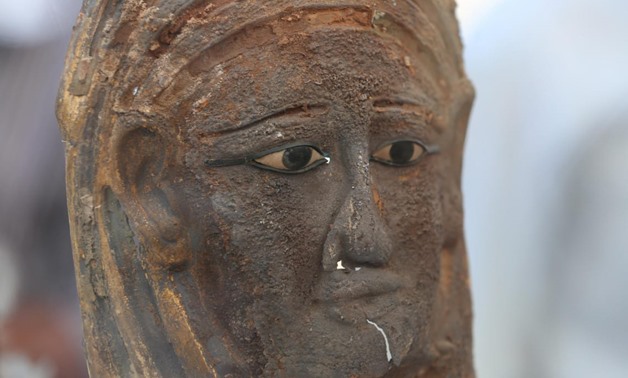http://www.egypttoday.com/Article/4/53976/In-pics-Discovered-mask-in-Saqqara-might-belong-to-priest
 A discovered item found in one of the five stone coffins uncovered in Saqqara area, Giza. The new discovery dates back to the late period of Ancient Egypt, from the seventh century BC to the fifth century BC - Hussein Talal/Egypt Today
A discovered item found in one of the five stone coffins uncovered in Saqqara area, Giza. The new discovery dates back to the late period of Ancient Egypt, from the seventh century BC to the fifth century BC - Hussein Talal/Egypt Today In pics: Discovered mask in Saqqara might belong to priest during 26th dynasty
By: Angy Essam
Sat, Jul. 14, 2018
"There is a layer of masking and calcification on the discovered mask, after initial examination, it was found that the mask was made of gold-plated silver while his eyes was made of Black Onyx," Hussein declared to the media on the sidelines of the press conference.

Some of the discovered items at five stone coffins uncovered at Saqqara area. The new archaeological discovery in Saqqara dates back to the late period of Ancient Egypt, from the seventh century BC to the fifth century BC - Hussein Talal/Egypt Today

The site of the new archaeological discovery at Saqqara area, Giza. The discovery dates back to the late period of Ancient Egypt, from the seventh century BC to the fifth century BC - Hussein Talal/Egypt Today
The head of the supreme council of Antiquities Mostafa Waziry announced that the importance of this discovery lies in that it was found in Saqqara, which no archaeological mission had visited since 1900.
Waziry pointed out that the discovered mummification workshop hosted 1,500 Ushabti statues, explaining that the well in which the workshop is located in is connected to another well and is expected to be uncovered during the upcoming period.

Some of the discovered items at five stone coffins uncovered at Saqqara area. The new archaeological discovery in Saqqara dates back to the late period of Ancient Egypt, from the seventh century BC to the fifth century BC - Hussein Talal/Egypt Today

Some of the discovered items at five stone coffins uncovered at Saqqara area. The new archaeological discovery in Saqqara dates back to the late period of Ancient Egypt, from the seventh century BC to the fifth century BC - Hussein Talal/Egypt Today
Minister of Antiquities Khaled Anany announced on Saturday the discovery of more than five stone coffins at Saqqara area, and declared it "a great archaeological discovery".
Anany added that the Egyptian-German mission succeeded in uncovering a complete mummification workshop which contains burial chambers with mummies dating back to the 26th and 27th dynasty.

Some of the discovered items at five stone coffins uncovered at Saqqara area. The new archaeological discovery in Saqqara dates back to the late period of Ancient Egypt, from the seventh century BC to the fifth century BC - Hussein Talal/Egypt Today

Some of the discovered items at five stone coffins uncovered at Saqqara area. The new archaeological discovery in Saqqara dates back to the late period of Ancient Egypt, from the seventh century BC to the fifth century BC - Hussein Talal/Egypt Today
A gilded mummy mask decorated with half-precious stones was discovered covering the face of one of the mummies. The discovered items included three mummies, a group of canopic vessels made of calcite and a number of Ushabtis as well.
Anany stressed that the new archaeological discovery in Saqqara dates back to the late period of Ancient Egypt, from the seventh century BC to the fifth century BC.
"The importance of such a discovery lies in its relevance to an important issue that the whole world is concerned with, which is the mummification, methods of embalming, its workshops and tools," Anany recounted in the press conference.
-- Sent from my Linux system.
No comments:
Post a Comment